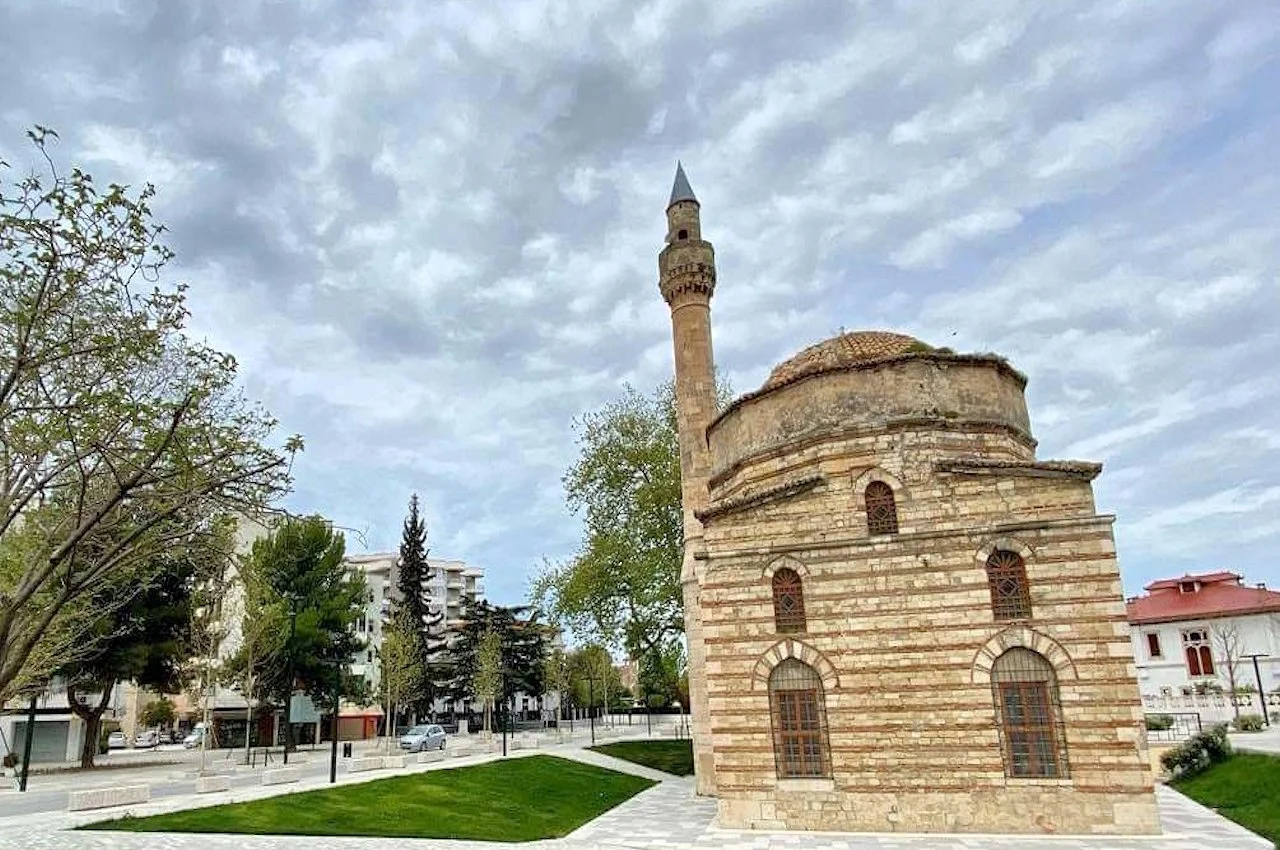Key Takeaways
- Muradie Mosque is a symbol of Albania’s rich history and cultural diversity.
- Built in 1542 during the Ottoman Empire, it showcases a unique architectural blend.
- The mosque features a minaret, dome, and intricate geometric patterns and calligraphy.
- It has played a central role in community life, religious practices, and Albanian history, surviving through periods of change.
- Preservation efforts continue to safeguard this heritage site for future generations.
Table of contents
- Historical Background of the Muradie Mosque
- Architectural Features of Muradie Mosque
- Cultural and Religious Significance
- Location and Visitor Information
- Preservation and Conservation Efforts
Discovering the Muradie Mosque is like opening a window to Albania’s layered history—where architecture, faith, and resilience intertwine.
Historical Background of the Muradie Mosque
Date of Construction and Founding Figures: Legacy of the Ottoman Empire
The Muradie Mosque was constructed in 1542, during the height of the Ottoman Empire. It was commissioned by Sultan Suleiman the Magnificent, symbolizing Ottoman authority and Islamic influence in Albania. According to local tradition, Murad Bey, an influential regional figure, may also have contributed to its establishment. This mosque stands as a tangible reminder of the empire’s vast reach, blending Ottoman architectural elements with local Albanian artistry. Its enduring presence marks a period when religious and political power converged through beautiful architecture, serving as an emblem of both spiritual devotion and imperial strength.
Historical Context: Albania Under Ottoman Influence
In the 16th century, Albania was firmly within the Ottoman domain. Ottoman rule introduced Islamic architecture, governance, and cultural practices, transforming local landscapes. Despite the foreign influence, Albanian society managed to maintain distinct traditions, resulting in a cultural mosaic that is reflected in the mosque’s architecture. Muradie served multiple roles: as a religious sanctuary, a symbol of Ottoman supremacy, and a community hub. Its construction also played a part in spreading Islam throughout the region, with the mosque becoming a cornerstone of religious and cultural life that still echoes through the centuries.
Role Through Historical Periods: From National Awakening to the Communist Era
Over the centuries, Muradie has been more than just a place of worship. During the Albanian National Awakening, it served as a gathering spot for patriots, playing a part in the birth of national identity. During Albania’s communist era, religious practices were suppressed, and the mosque was closed, yet it was preserved as a significant historical monument, not destroyed—highlighting its architectural and cultural value. After the fall of communism, Muradie was reopened, symbolizing the resilience of Albanian spiritual life and cultural continuity, standing as a proud testament to enduring faith and identity.
Architectural Features of Muradie Mosque
Architectural Style and Influences: A Blend of Ottoman and Albanian Design
The Muradie Mosque displays a distinctive blend of Ottoman and local Albanian architectural elements. Its smaller size contrasts with the grandeur of larger mosques, yet its elegance and detailed craftsmanship speak volumes. The structure incorporates intricate stone carvings and harmonic proportions that showcase regional adaptations of Ottoman styles. This fusion makes it a unique example of cultural synthesis, reflecting both the empire’s influence and local artistry. The mosque’s design embodies harmony, simplicity, and detail, inspiring visitors with its understated beauty.
Key Elements: Minaret, Dome, Prayer Hall, and Decoration
- Minaret: Tall and slender, the minaret is used for the call to prayer and is decorated with detailed carvings that exemplify Ottoman craftsmanship.
- Dome: The central dome symbolizes the heavens, creating a focal point for the prayer hall. Its harmonious proportions blend practicality and beauty.
- Prayer Hall: Inside, the hall faces Mecca, designed to facilitate communal worship and spiritual unity among visitors.
- Decoration: The interior and exterior are adorned with geometric patterns, floral artwork, and calligraphy, all rich in symbolism that reflects Islamic art influences and the cultural blend.
Unique and Distinguishing Features: Character and Charm
Unlike larger, more imposing mosques, Muradie captivates with its refined modesty and intricate detail. Its architecture and decorations convey a sense of warmth and intimacy. The subtlety of its design, combined with regional adaptations, makes it stand out as a unique architectural jewel that balances grandeur with approachability. Visitors often remark on its welcoming character and the peaceful ambiance that pervades its spaces, making it a cherished site in Vlorë’s landscape.
Cultural and Religious Significance
Importance to the Local Muslim Community: A Pillar of Togetherness
The Muradie Mosque is a lifeline for the Muslim community in Vlorë. It is the primary space for daily prayers and religious celebrations such as Eid. Beyond its spiritual role, it serves as a meeting point for religious education, charitable work, and communal bonding. The mosque’s presence nurtures a sense of belonging and spiritual continuity, fostering unity within the local Muslim population and beyond, reinforcing the importance of faith in everyday life.
Role in Albanian Islamic Culture and Religious Practices: Keeping Traditions Alive
The mosque acts as a custodian of Albanian Islamic culture, providing religious education and maintaining traditions that have been passed down through generations. It promotes Islamic values and facilitates practice of religious rituals, such as Quran recitation, prayer, and religious festivals. Its role as a cultural hub helps preserve and promote Islamic heritage within a diverse Albanian society, fostering intergenerational transmission of faith and knowledge.
Events, Festivals, and Community Activities: Vibrant Celebrations
Throughout the year, Muradie hosts many religious festivals, prayers, and community gatherings. Major Islamic holidays like Eid are celebrated with prayer services, festive meals, and social activities. The mosque also organizes educational programs, Quran recitations, and interfaith dialogues, fostering understanding and unity among different communities. These vibrant events reinforce Muradie’s role as a dynamic center of faith, culture, and community in Vlorë.
Location and Visitor Information
Location: Nestled in Vlorë, Albania
The Muradie Mosque is located in the historic city of Vlorë, in southwestern Albania. This city is renowned as the birthplace of Albanian independence and offers a picturesque coastal setting. Its strategic position along the Adriatic Sea makes the mosque accessible and central within the city, allowing visitors to combine cultural exploration with enjoying Vlorë’s scenic beauty. Visiting this site offers a deep dive into Albania’s layered history, culture, and spiritual heritage.
Accessibility and Visitor Tips
The mosque welcomes visitors from all backgrounds. It is centrally located and easy to reach by pedestrian pathways or public transportation. When visiting, modest attire is recommended—women should consider bringing a headscarf, and all visitors are encouraged to show respect for its sacred space. Entry is free, but donations are appreciated to support maintenance. To ensure an enjoyable experience, contact local tourist centers for opening hours and guidelines, and remember to observe local customs to honor the mosque’s significance.
Nearby Attractions: A Journey Through Time
While in Vlorë, explore the Independence Museum to learn about Albania’s road to independence. For panoramic views, visit Kaninë Castle, which overlooks the city’s coast. Relax at nearby beaches along the Albanian Riviera. These sites, combined with Muradie Mosque, create an enriching travel experience—blending history, natural beauty, and culture—a perfect itinerary for curious explorers.
Preservation and Conservation Efforts
Current Condition and Restoration Projects: Safeguarding a Heritage
The Muradie Mosque has undergone significant restoration to preserve its structural and artistic integrity. Damage from natural events like earthquakes and the effects of aging prompted recent repairs, including stabilizing foundations and restoring decorative elements. Ongoing projects aim to safeguard the mosque’s features, ensuring it remains a vibrant historical monument. These efforts involve local authorities, cultural organizations, and international partners dedicated to maintaining Albania’s architectural heritage for future generations.
Government and Cultural Organizations: Guardians of Albanian Heritage
The preservation of the Muradie Mosque benefits from collaboration between the Albanian government and cultural preservation NGOs. Funding, expert restoration, and awareness campaigns aim to protect this precious site. Efforts focus on both conserving the physical structure and promoting its significance to local and international audiences, making it a symbol of cultural pride.
Importance of Preservation: Safeguarding Cultural Heritage
Maintaining the Muradie Mosque is vital to keep alive a historical and spiritual legacy. It embodies the rich cultural tapestry of Albania, representing past influences and the resilience of its people. Preservation not only protects architecture but also reinforces the identity and continuity of Albanian heritage. Supporting these efforts ensures that future generations can continue to learn from and be inspired by this enduring monument.



0 Comment